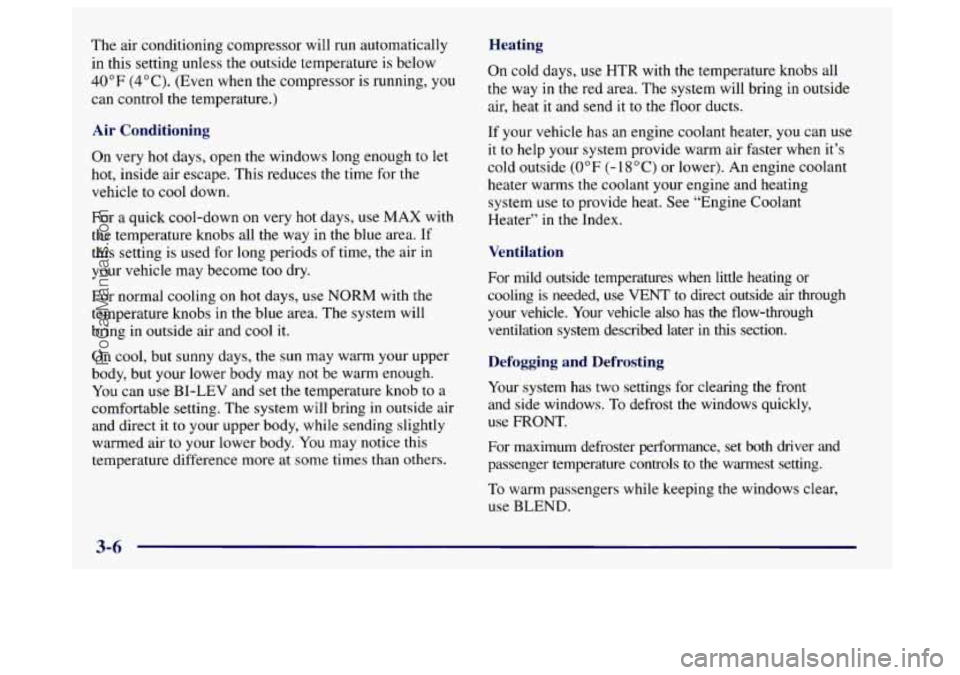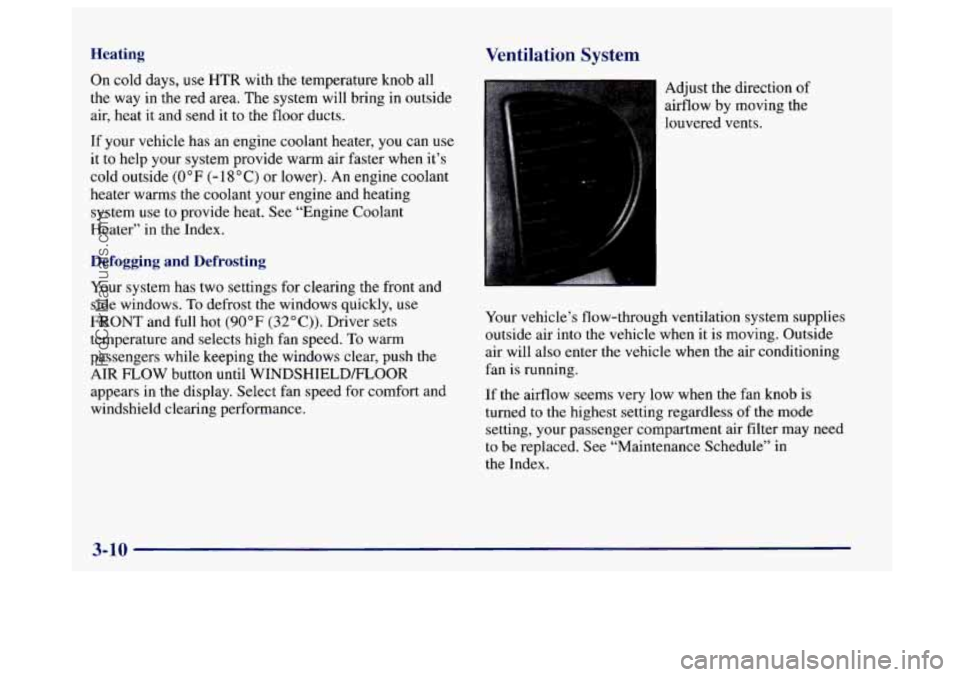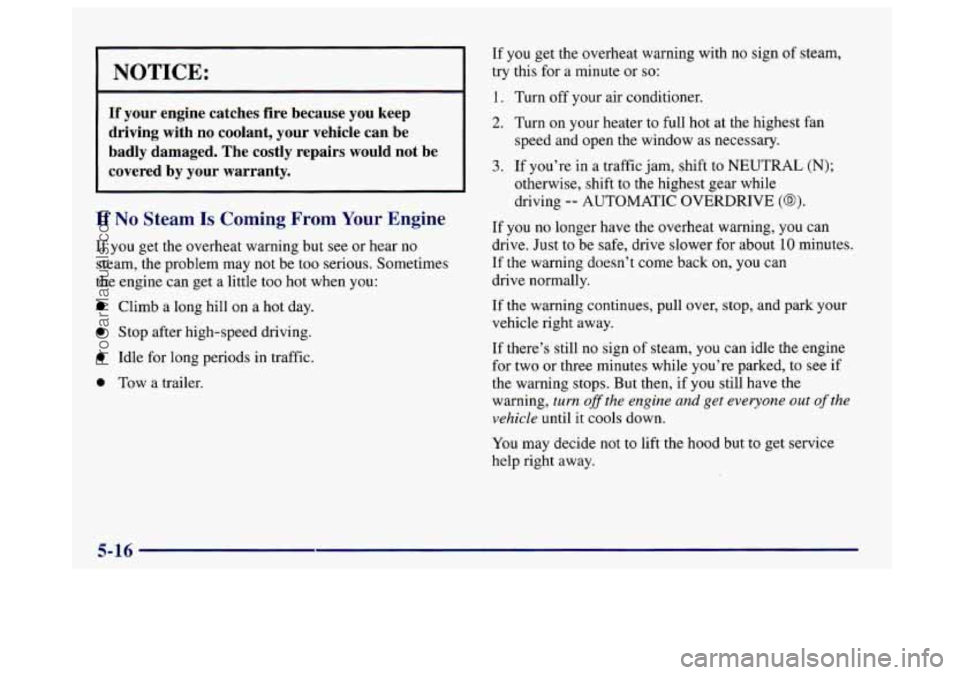Page 150 of 406

The air conditioning compressor will run automatically
in this setting unless the outside temperature is below
40°F
(4°C). (Even when the compressor is running, you
can control the temperature.)
Air Conditioning
On very hot days, open the windows long enough to let
hot, inside air escape. This reduces the time for the
vehicle to cool down.
For a quick cool-down on very hot days, use MAX with
the temperature knobs all the way in the blue area. If
this setting is used for long periods of time, the air
in
your vehicle may become too dry.
For normal cooling on
hot days, use NORM with the
temperature knobs in the blue area. The system will
bring in outside air and cool it.
On cool, but sunny days, the
sun may warm your upper
body, but your lower body may not be warm enough.
You can
use BI-LEV and set the temperature knob to a
comfortable setting. The system will bring in outside air
and direct it to your upper body, while sending slightly
warmed air to your lower body.
You may notice this
temperature difference more at some times than others.
Heating
On cold days, use HTR with the temperature knobs all
the way
in the red area. The system will bring in outside
air, heat it and send
it to the floor ducts.
If your vehicle has an engine coolant heater, you can
use
it to help your system provide warm air faster when it’s
cold outside (0°F
(- 1 SOC) or lower). An engine coolant
heater warms the coolant your engine and heating
system use to provide heat. See “Engine Coolant
Heater” in
the Index.
Ventilation
For mild outside temperatures when little heating or
cooling is needed, use
VENT to direct outside air through
your vehicle. Your vehicle also has the flow-through
ventilation system described later in this section.
Defogging and Defrosting
Your system has two settings for clearing the front
and side windows. To defrost
the windows quickly,
use
FRONT.
For maximum defroster performance, set both driver and
passenger temperature controls to the warmest setting.
To warm passengers while keeping the windows clear,
use
BLEND.
ProCarManuals.com
Page 154 of 406

Heating Ventilation System
On cold days, use HTR with the temperature knob all
the way in the red area. The system will bring in outside
air, heat it and send it to the floor ducts.
If your vehicle has an engine coolant heater, you can
use
it to help your system provide warm air faster when it’s
cold outside
(0°F (-18°C) or lower). An engine coolant
heater warms the coolant your engine and heating
system use to provide heat. See “Engine Coolant
Heater” in the Index.
Defogging and Defrosting
Your system has two settings for clearing the front and
side windows.
To defrost the windows quickly, use
FRONT and full hot (90°F (32°C)). Driver sets
temperature and selects high fan speed.
To warm
passengers while keeping the windows clear, push the
AIR FLOW button until WINDSHIELD/FLOOR
appears in the display. Select fan speed for comfort and
windshield clearing performance. Adjust the direction
of
airflow
by moving the
louvered vents.
Your vehicle’s flow-through ventilation system supplies
outside air into the vehicle when it is moving. Outside
air will also enter the vehicle when the air conditioning
fan is running.
If the airflow seems very low when the fan knob is
turned to the highest setting regardless of the mode
setting, your passenger compartment air filter may need
to be replaced. See “Maintenance Schedule” in
the Index.
3-10
ProCarManuals.com
Page 241 of 406
Engine Overheating
You will find a coolant temperature gage and a hot
engine warning light on your instrument panel. See
“Engine Coolant Temperature Gage” and “Engine
Coolant Temperature Warning Light” in the Index. You
also have a low coolant warning light on your
instrument panel. See “Low Coolant Light” in the Index.
If Steam Is Coming From Your Engine
Steam from an overheated engine can burn you
badly, even if you just open the hood. Stay away
from the engine if you see
or hear steam coming
from it. Just turn it off and get everyone away
from the vehicle until it cools down. Wait until
there is no sign of steam or coolant before you
open the hood.
If you keep driving when your engine is
overheated, the liquids in
it can catch fire. You or
others could be badly burned. Stop your engine
if
it overheats, and get out of the vehicle until the
engine
is cool.
5-15
ProCarManuals.com
Page 242 of 406

NOTICE:
If you get the overheat warning with no sign of steam,
try this for a minute or so:
1. Turn off your air conditioner.
If your engine catches fire because you keep
driving with no coolant, your vehicle can be
badly damaged. The costly repairs would not be
covered by your warranty.
3. If you’re in a traffic jam, shift to NEUTRAL (N);
2. Turn on your heater to full hot at the highest fan
speed and open the window as necessary.
otherwise, shift to the highest gear while
driving
-- AUTOMATIC OVERDRIVE (a).
If No Steam Is Coming From Your Engine
If you get the overheat warning but see or hear no
steam, the problem may not be too serious. Sometimes
the engine can get a little too hot when you:
Climb a long hill on a hot day.
0 Stop after high-speed driving.
0 Idle for long periods in traffic.
0 Tow a trailer. If you
no longer have the overheat warning, you can
drive. Just
to be safe, drive slower for about 10 minutes.
If the warning doesn’t come back on, you can
drive normally.
If
the warning continues, pull over, stop, and park your
vehicle right away.
If there’s still no sign
of steam, you can idle the engine
for two or three minutes while you’re parked,
to see if
the warning stops. But then, if you still have the
warning,
turn ofthe engine and get everyone out of the
vehicle
until it cools down.
You may decide not to lift the hood but
to get service
help right away.
5-16
ProCarManuals.com
Page 243 of 406
Cooling System
When you decide it’s safe to lift the hood, here’s what
you’ll see:
I
A
A. Coolant Recovery Tank
B. Electric Engine Fans
C. Radiator Pressure
Cap
I
’ A CAUTION: I
An electric fan under the hood can start up even
when the engine
is not running and can injure
you. Keep hands, clothing and tools away from
any underhood electric fan.
If the coolant inside the coolant recovery tank is boiling,
don’t do anything else until it
cools down.
5-17
ProCarManuals.com
Page 244 of 406
The coolant level should be at or above the COLD mark
on the overflow hose in the coolant bottle.
If it isn’t, you may have a leak in the radiator hoses,
heater hoses, radiator, water pump
or somewhere else in
the cooling system.
r
r
Heater and radiator hoses, and other engine
parts, can be very hot. Don’t touch them.
If you
do, you can be burned.
Don’t run the engine if there
is a leak. If you run
the engine, it could lose all coolant. That could
cause an engine fire, and you could be burned.
Get any leak fixed before you drive the vehicle.
1 NOTICE:
r
Engine damage from running your engine
without coolant isn’t covered
by your warranty.
If there seems to be no leak, with the engine on, check to
see if the electric engine fans are running.
If the engine
is overheating, both fans should be running. If they
aren’t, your vehicle needs service.
5-18
ProCarManuals.com
Page 245 of 406
How to Add Coolant to the Coolant
Recovery Tank
If you haven’t found a problem yet, but the coolant
level isn’t at the
COLD mark, add a 50/50 mixture
of
clean water (preferably distilled) and DEX-COOL@
(silicate-free) antifreeze at the coolant recovery
tank. (See “Engine Coolant” in the Index for
more information.)
A CA ‘JTION:
-
Adding only plain water to your cooling system
can be dangerous. Plain water, or some other
liquid like alcohol, can boil before the proper
coolant mix will. Your vehicle’s coolant warning
system is set for the proper coolant
mix. With
plain water or the wrong mix, your engine could
get too hot but you wouldn’t get the overheat
warning. Your engine could catch fire and you or
others could be burned. Use a
50/50 mix of clean
water and
DEX-COOL@ coolant.
I
NOTICE:
In cold weather, water can freeze and crack the
engine, radiator, heater core and other parts.
Use the recommended coolant and the proper
coolant mix.
5-19
ProCarManuals.com
Page 246 of 406
. I
You can be burned if you spill coolant on hot
engine parts. Coolant contains ethylene glycol
and it will burn if the engine parts are hot
enough. Don't spill coolant on a hot engine.
When
the coolant in the coolant recovery tank is at the
COLD mark, start your vehicle.
If the overheat warning continues, there's one more
thing you can try.
You can add the proper coolant mix
directly to the radiator, but be sure the cooling system is
cool before you do it.
A CAUTION:
I
Steam and scalding liquids from a hot cooling
system can blow out and burn you badly. They
are under pressure, and if you turn the radiator
pressure cap
-- even a little -- they can come out
at high speed. Never turn the cap when the
cooling system, including the radiator pressure
cap, is hot. Wait for the cooling system and
radiator pressure cap to cool
if you ever have to
turn the pressure cap.
5-20
ProCarManuals.com